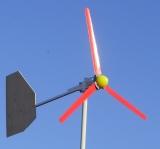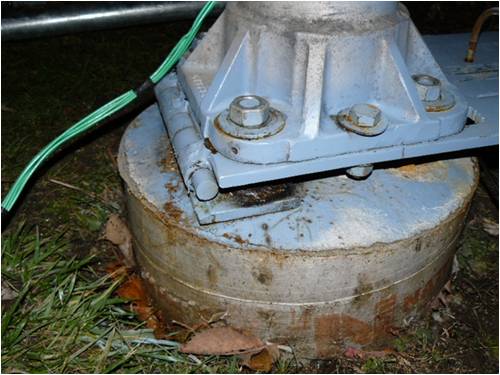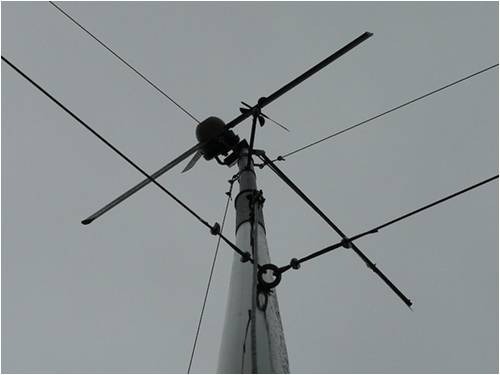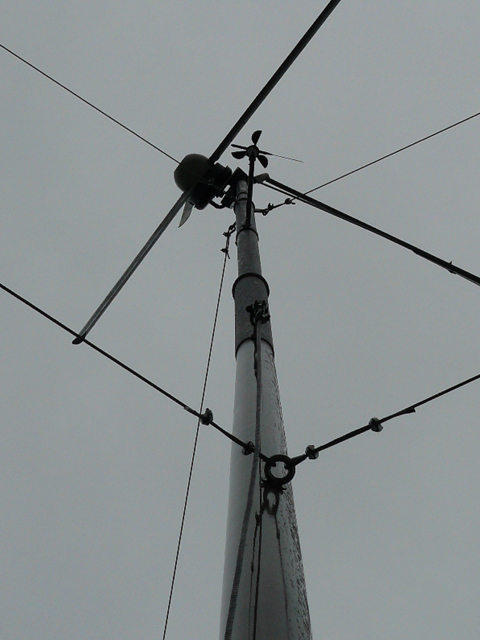
|

|
Forum Index : Windmills : How close to your home
| Author | Message | ||||
| imsmooth Senior Member Joined: 07/02/2008 Location: United StatesPosts: 214 |
I asked this on Fieldlines, but I would like to hear from others here that do not go to that site: does anyone have a wind tower that is within striking distance of their home if it fell, or is the fall zone away from the home? This all comes down to how much you trust your cables, anchors and engineering. |
||||
| GWatPE Senior Member Joined: 01/09/2006 Location: AustraliaPosts: 2127 |
Hi imsmooth, my windmill towers are attached to my home. The guys are akin to ornaments. I think my home would blow away the same time the windmill did. In suburbia, it is better to have any damage occur to your own place if things go wrong. Gordon. become more energy aware |
||||
| Gizmo Admin Group Joined: 05/06/2004 Location: AustraliaPosts: 5166 |
My towers are only 7 meters tall, and about 15 meters from the house. I would not have a tower close enough to the house that it could cause damage if it fell. I dont worry so much in normal day to day running, but I do worry during raising and lowing the tower for maintenance. From what I can see most towers come crashing down when they are been worked on. But I did have one come down when a storm passed by and pulled the concrete guy wire anchor out of the water soaked ground. If its really windy I keep my distance, just in case. In suburbia you dont have much choice, either keep the tower short or, if it can fall, make sure its not on the neighbours property. Glenn I should add, as much as I'm into wind energy, if I lived in suburbia and the neighbour had a windmill on a 20m tower, that could fall on my place, I would be asking him to take it down or use a shorter tower. The best time to plant a tree was twenty years ago, the second best time is right now. JAQ |
||||
| GWatPE Senior Member Joined: 01/09/2006 Location: AustraliaPosts: 2127 |
Hi Glenn, In suburbia, a 20m tower would likely fall across 2 blocks. Many blocks are only 10m frontage in the toy town burbs. Gordon. become more energy aware |
||||
| imsmooth Senior Member Joined: 07/02/2008 Location: United StatesPosts: 214 |
Glenn, I have heard many say that tower failures usually occur while they are being serviced. Is this because of the high load moment when the tower is near horizontal? Do some towers fail from buckling when they are near vertical? Is there a table with buckling load limits for various schedule steel tubing? Edit: I found a link on buckling and some info in my Timeshenko book. If I did my calc right a 42' 2.87" OD tower can take about 400-450lbs of compression before buckling. This would be for pure axial loading. buckling link If this is the case I don't see how there are tower kits using 2.5" schedule 40 pipe for anything over 40'. It would seem that these towers would buckle from their own weight with a 100-150lb generator on top. |
||||
| KarlJ Guru Joined: 19/05/2008 Location: AustraliaPosts: 1178 |
the gin poles in such have guys attached up the mast and its intended that the side guys (90 deg apart idea) are set before raising. That said everything I have read says be very careful when raising such as beast as if it does come crashing down the wires may cut you into little pieces. Luck favours the well prepared |
||||
| imsmooth Senior Member Joined: 07/02/2008 Location: United StatesPosts: 214 |
Does anyone have any stories of tower failures during raising or during high winds that he/she would like to share? |
||||
| KarlJ Guru Joined: 19/05/2008 Location: AustraliaPosts: 1178 |
see Phillspic of the guy star picket pulled out of the normally hard ground, I'm thinking anything like this needs to be set in concrete. test by attaching tractor and trying to drive away! Karl Luck favours the well prepared |
||||
Tim_the_bloke Senior Member Joined: 15/11/2009 Location: AustraliaPosts: 105 |
imsmooth asks: Does anyone have any stories of tower failures during raising or during high winds that he/she would like to share? Well, I have dropped a tower. It has a gin pole and I was lowering it when half way down, the gin pole decided to turn sideways and let the tower fall towards the side. It made a crash but was not totally trashed. I have repaired it and got it back up. No human injuries but the tower still shows a slight bend. There is a lot of leverage involved with a lump of heavy machinery at the top of a tower. It is in lowering and raising that the danger is greatly increased - people will be nearby (me) and the forces are dynamic rather than static. Wind loads are easier to design for. The problem was in that the gin pole need better guy lines. The site is not level. The gin pole guys were anchored below the piviot height of the tower. This has been corrected but was the fatal flaw. |
||||
| windlight Guru Joined: 03/03/2007 Location: AustraliaPosts: 331 |
I could tell you about this...... http://www.anotherpower.com/gallery/album111/sh*t_happens_sm all_001 "I like this place and willingly could waste my time in it" - (Act II, Scene IV). |
||||
Downwind Guru Joined: 09/09/2009 Location: AustraliaPosts: 2333 |
I have not seen a mill tower crash during rasing or lowering, but did witness an oil rig derrick (large 3 stand rig capable of 15000 ft depth) come crashing down on lowering the derrick for a move. We had noticed a damaged section in the bridal line the night before and on reporting it was told to paint the damaged section red. Well red paint donít hold broken strands in heavy cable together very well. Rather than wait for a replacement bridal line to be shipped in at a high day rate cost on standby, the decision to lower the derrick at first light was made. Like most towers the heaviest point is around horizontal and at this point a series of loud cracking sounds were heard, resulting from the remaining cable strands failing. I watched the little fat tool pusher run backwards away from the falling mass and trip over a pile of sand landing flat on his ass while the rig crashed to the ground around him. The crown section was badly bent and damaged and took 3 weeks to be repaired and the whole structure required crack testing of every single weld before it could be commissioned for operation again. Total cost was most likely into the $M. It was only luck that no one was hurt or killed from this disaster and a decision of pure stupidity. Moral of the story is dont use red paint to repair structural faults and sometimes it pays to wait rather than take risks. Pete. Sometimes it just works |
||||
| JimBo911 Senior Member Joined: 26/03/2009 Location: United StatesPosts: 262 |
imsmooth A few pictures of my present setup. Screw in auger, tower hinge plate with gin pole u bolts. Hey the neo,s are working great. 60 series F&P 700 watts. Thanks again. 


Jim |
||||
| GWatPE Senior Member Joined: 01/09/2006 Location: AustraliaPosts: 2127 |
Hi Jim, the hinged base with detatchable gin pole should work well. I hope you intend to fully wire all the D shackles and the turn buckles. Post a picture with them all wired, and I will post a positive comment. I have seem the results of a pin working loose on a D shackle, and a separate instance with a turnbuckle unwinding. Not pretty. Mechanical devices need periodic checking and maintenance. Gordon. become more energy aware |
||||
| imsmooth Senior Member Joined: 07/02/2008 Location: United StatesPosts: 214 |
Jim, I am glad to hear that your project is making power with the arc magnets. I don't think many know that this is an option for improved power from the F&P. See arc neo magnets How tall is your tower and what size guy wires do you have? The pole looks pretty wide. How far is it from your house? |
||||
| KarlJ Guru Joined: 19/05/2008 Location: AustraliaPosts: 1178 |
$200 odd for neo's wow thats expensive Phill reckons the startup torque required with these was prohibitive, whats your thoughts? any problems with distortion of the rotor in your setup imsmooth? how was the cogging? Oh and the mercury slip ring idea, what did that cost? and where did you get it... cancel that it's a mercotac and hideously expensive! Karl Luck favours the well prepared |
||||
| JimBo911 Senior Member Joined: 26/03/2009 Location: United StatesPosts: 262 |
Gordon It took me a long time to get that dam hinge plate to work. It pivots on an fixed ark with no other movement getting the bolts to line up wasn't easy. The mounting bolts farthest away from the hinge worked OK because the holes in the tower came down on them with less of an ark but the closer ones gave me a hard time. I got the idea of a hinge plate from the till up tower kit you can buy from South West Wind they sell it with there SkyStream 3.7 The reason I like the hinge plate is because the plate will only let the tower till in one direction. (North South etc) Thinking that this would make tilling a lot safer and easier. All of the 5/16 shackles do have cotter pins in them, the one and only 5/8 shackle does not I WILL CHANGE THAT. Never thought of the turn buckles working lose, will take your advice and modify them accordingly. imsmooth Yeah I am glad that I went with your neo's 700 watts peak (so far) definitely surprised me. Together with one of Gordons caps/doubler it seems to be working well. It did involve more work but I am now reaping the rewards of your design. Other forum members have had difficulty stopping there F&P mills with dynamic braking. My mill has shut down each and very time and quickly I might add. My tower believe it or not starts out with a 30' used, aluminum, tapered, flag pole. I got REAL lucky and sourced it from a friend for free. Just so happens that a 4" inch id pipe (4" galvanized imc electrical conduit) slips over the top the alum flag pole and goes down about 3 feet with the flag pole being tapered it fits nicely and is centered perfectly, I had to machine a spacing bushing (PVC) to take up the clearance between the pole and pipe at the top of the alm pole. The 4" imc conduit extends two feet above the flag pole, total length of the the 4" conduit is 5'. From there I used a 4" to 3" galvanized reducing coupling ($60.00 ouch) to a 10 foot length of 3" imc galvanized conduit. Then again from the 3" to 2" galvanized water pipe. The 2" pipe is 5' long and gives me more blade to tower clearance. Cable specs are 1/4 inch dia , 7*7 strand, 1220 lbs working load, 1880 lbs breaking. The mill sits up 47' with the blade tips another 4'6". I have a 50' height ordinance over here. Truth be told at 47' tilling it up and down has some scary moments not sure if I would care to till anything taller. I built a small room addition on my house several years ago the tower is approximately 35' from the addition if it did come down in the direction of my addition it would hit. My neighbor applied for a height variance with the county to get a permit for his mill, the county insisted that the tower have a fall zone and be fenced in. Karl Yup the neo's were expensive but I feel well worth the extra work and expense. (now that it works) With an 36 finger F&P stator there is no clogging even with the neo's. As I was placing (building) the neo's in the rotor I temporarily installed the stator with some but not all of the magnets, I couldn't turn the rotor without using a pair of channel locks but when all magnets where installed there was no clogging. Testing on my lath proved that the neo's at least doubled the out put over the ceramic magnets. Turns out now that my mill is flying wind the (of course) is much stronger than my lath and the power out put is better than expected. Hey I still have my finger crossed the wind is a mighty flicked thing. Some luck and lot of help from the forum members is what's made this happen. 

Jim |
||||
SparWeb Senior Member Joined: 17/04/2008 Location: CanadaPosts: 196 |
Jimbo, I love the tower pictures. Great examples of how to do this stuff and learning from the pro's. [quote]1/4 inch dia , 7*7 strand, 1220 lbs working load, 1880 lbs breaking[/quote] 1/4" cable usually has a breaking load of 5000-7000 pounds, expecially the better grades like aircraft 7x19. The stuff I have even has a Mil-Spec on the label. If your wire rope really came with those numbers, and that's not a typo, I'd be very worried. Like me, you've found that 40-50 feet is about the tallest tower that an amateur can build and handle, and even that pushes the comfort zone. I remember a comment either from Dan B. or Hugh P. that the tower hinge should have a fair bit of "slop" and that's why they like pipe turning around a pipe where there's about 1/8" clearance between the tubes and lots of area to weld the joint. Have you read Paul Gipe's book? Lots of tower info. Imsmooth: If you can read Timoshenko and run the column buckling numbers, but you still don't understand tower loads, you just haven't done enough work yet. Sorry for the prickly answer - not trying to flame. Kind of a mixed message between the question you ask and the comments you give afterward. Steven T. Fahey |
||||
| imsmooth Senior Member Joined: 07/02/2008 Location: United StatesPosts: 214 |
Karl, The magnets are a little expensive, but they work really well. They are curved to fit the steel of the rotor, reinforcing its strength. They are slanted to significantly reduce cogging. When coupled with filing the stator iron cores the cogging is almost gone when testing the rotor on a lathe. When connected to the blades you can not feel any cogging. My rotor started in the slightest winds. It's just a question if the extra power is worth the extra dollars. If anyone is interested I can have my source make more and have them directly shipped to you. They are almost at cost. Steve, My question is to compare what I have read and calculated with the experience of others. I was curious how and when towers have failed for others. My field experience is limited, but I would think that the failure would either occcur at maximum moment arm, which is near horizontal; or, the failure would be buckling when near vertical. I did not consider how the guy wire would help with the latter. |
||||
SparWeb Senior Member Joined: 17/04/2008 Location: CanadaPosts: 196 |
|
||||
Tim_the_bloke Senior Member Joined: 15/11/2009 Location: AustraliaPosts: 105 |
Guy wires deserve a lot of consideration. When the tower is up, you tighten the guy wires with turnbuckles, then saftey wire up the turnbuckles. This should give you a stable equilibrium. However, lowering the tower is breaking the equilibrium. Lest assume your tower has 4 guy wires. One you release to allow you to lower the tower. The tower pivots on some sort of hinge. The axis of this hinge is likely to be higher than the anchors for the side guy wires. This is OK while the tower is vertical. As soon as the tower starts to lower, the side guys will go slack. Slack guy wires are not controlling the lowering tower = dangerous. The tower may flop to one side (ie: shape itself to the ground). Imagine the triangle formed by the tower, guy wire and ground. Is this triangle exactly a right angle triangle? It would be an unusual tower to have the side guy wires anchored exactly in line with the axis of the hinge, and this means both triangles in the same plane. Gin poles deserve their own guy wires as well. |
||||
| The Back Shed's forum code is written, and hosted, in Australia. | © JAQ Software 2025 |